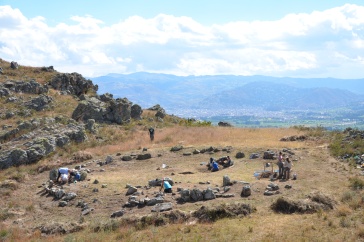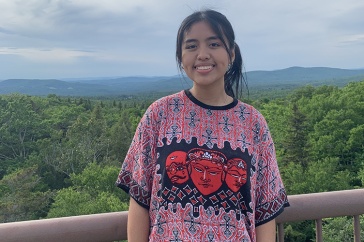
Charles-Nicholas Maulsby Beard ’17 presents his research during History URC and Alumni Day.
Professor Gerard Morin ’67G returned to the MUB on Thursday as the moderator for a panel of senior history majors, walking the same halls where he had presented a graduate paper five decades earlier.
“It was 50 years ago this month, and I’m glad to be back again,” he told the enthusiastic audience of faculty, staff, community members and students attending the event, “Vitriol, Violence and Diplomacy: From the Roman Republic to the Islamic State,” adding that the panel discussion about to begin would span an enormous period of time.
Alumni like Morin played an integral part in the history department’s 2017 URC and Alumni Day, with an alumni panel slated for later in the day. But at a little after noon in the MUB, the focus was on four students, their research and a journey from ancient Rome through Europe in the time of Richard II and Elizabeth I to modern history and the Islamic State.

History major Bethany Fraser ’17 of Rindge, New Hampshire, was first up, presenting on a portion of her senior thesis, “Tactical and Strategic Military Intelligence in the Late Roman Republic and Early Empire.”
With just 15 minutes allotted for each presentation, Fraser gave an in-depth look at the strategic policies of Julius Caesar and how Rome’s military intelligence challenged that of its counterparts.
Charles-Nicholas Beard ’17 of Amherst, New Hampshire, a German and history major, was next up at the lectern, discussing King Richard II of England and the German Hansa. For those in the room not familiar with the Hansa, he explained it was a league of merchants from Germany’s northern city-states in the 12th through 16th centuries.
“They were one of the most powerful established trade groups in Europe, so you didn’t want to get on their bad side,” he said, adding the Hansa, despite coming from conflicting cultures in some cases, “put aside differences and worked together toward their mutual benefit of their own volition.”
In examining the history of Richard II’s interactions with the Hansa, Beard explained he examined primary sources including letters from the royal court to determine the king had “something of a bipolar relationship with the Hansa.”

Mia Sacks ’17 of Brookline, New Hampshire, an art history and history major, shared her research on “Green Vitriol in Elizabethan and Stuart England: Chemistry and Politics.” Green vitriol, also known as coppras, was used for ink, dyes, leather-blacking and medicine in the time of Queen Elizabeth I. But, Sacks explained, there was a papal monopoly on its manufacture among Catholic countries. Queen Elizabeth had inherited a bankrupt kingdom, she noted, and access to green vitriol without paying high papal tariffs was essential.
As a protestant queen, “Nothing delighted Elizabeth and her counselors more than annoying the pope,” Sacks added. A monopoly by the monarchy would develop and last through the remaining Tudor-Stuart years, Sacks noted.
Sacks ended by taking a moment to thank the UNH community for the International Research Opportunities Program grant that will allow her to take her research to the next stage in the United Kingdom this summer.
Michaela Todd ’17, a history and international affairs major from Sandown, New Hampshire, ended the afternoon’s session with her presentation on “The Islamic State’s Media War on the West,” bringing the audience back to modern history with a look at the birth and growth of ISIS since 1999 and how militants manipulate their narrative with recruitment videos tailored to appeal to young adults of all nations.
She was inspired to research the topic after being in Pairs during the attacks there in 2015.
Todd shared examples of how Islamic State leaders use videos reminiscent of Hollywood blockbusters and hit online games to win over their target audience: tech-savvy young adults between the ages of 18 and 24. As of 2015-2016, she noted, the Islamic State was numbered at 6 million members: “larger than most small European countries.”
Her research revealed that Islamic State terrorists are far more media-savvy than she expected, and they use the internet and social media as recruiting tools.
History is relevant today, Todd added. To address the current issues, she said, “It is important to think about the background.”
-
Written By:
Jennifer Saunders | Communications and Public Affairs | jennifer.saunders@unh.edu | 603-862-3585




















































